4th Floor Artwork
Dusk, 2014
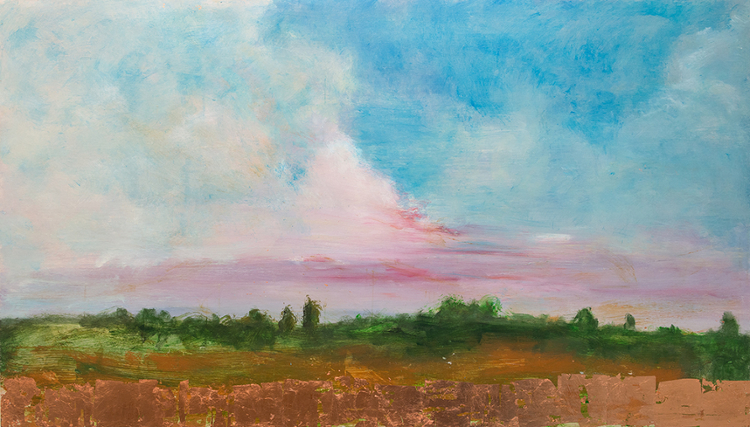
The Works of Bryson Brooks
Bryson Brooks is an internationally renowned artist and native of North Texas who is currently living and working in San Antonio. After completing his Bachelor of Fine Arts degree at the University of Texas at Austin, he moved to Mexico City, creating collaborative and individual works of art in the media of painting and performing arts.
The Dawn and Dusk landscapes depict the actual site of the A&M-SA campus. His paintings were gifted to the university by an art patron in honor of Dr. Maria Hernandez Ferrier’s inauguration as president of Texas A&M University-San Antonio, September 2010.
Bryson Brooks (American, 1975)
Dusk, 2014
Signed and inscribed on verso with date, title, “East” & “S.A.TX”
Oil on wood panel with gold leaf
4 x 7 feet
Through playful use of colors and lines the artist conveys great emotion in an impressionistic manner very idiosyncratic to his method.
Dawn, 2014

The Works of Bryson Brooks
Bryson Brooks is an internationally renowned artist and native of North Texas who is currently living and working in San Antonio. After completing his Bachelor of Fine Arts degree at the University of Texas at Austin, he moved to Mexico City, creating collaborative and individual works of art in the media of painting and performing arts.
The Dawn and Dusk landscapes depict the actual site of the A&M-SA campus. His paintings were gifted to the university by an art patron in honor of Dr. Maria Hernandez Ferrier’s inauguration as president of Texas A&M University-San Antonio, September 2010.
Bryson Brooks (American, 1975)
Dawn, 2014
Signed and inscribed on verso with date, title, “West” & “S.A.TX”
Oil on wood panel with silver leaf
4 x 7 feet
The artist takes the viewer to a dreamlike landscape both surreal and less representational with free use of smudged effects and metallic applications.
Portrait of the Alamo
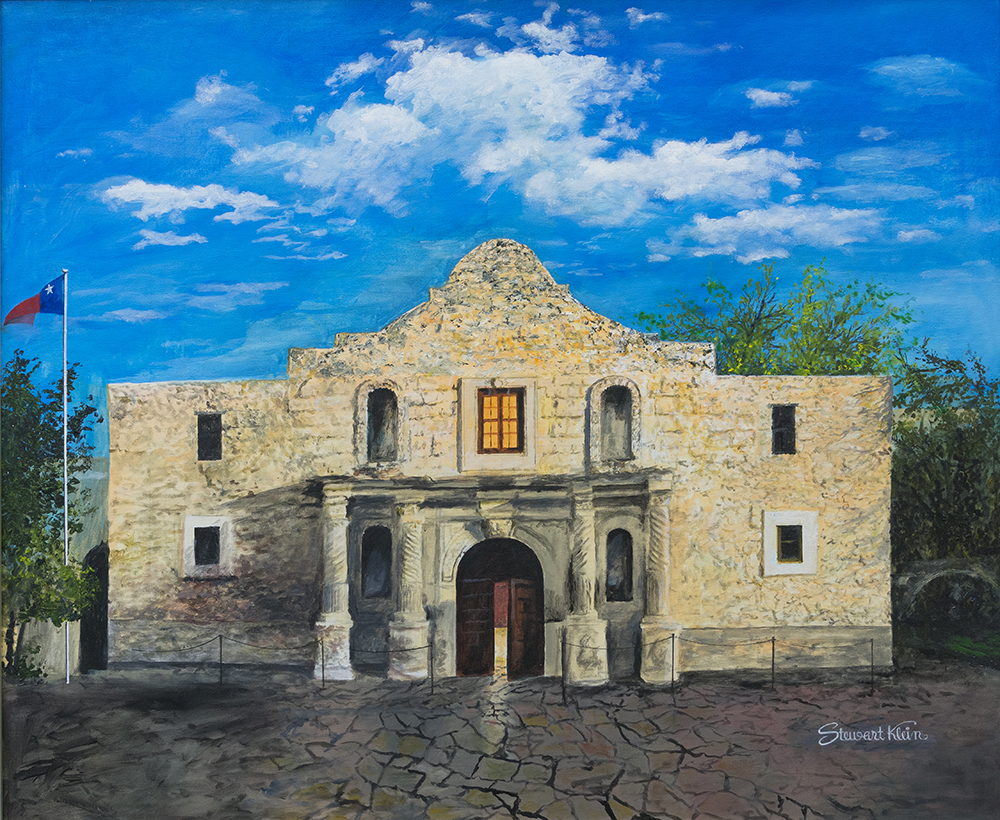
The Works of Stewart Klein
Recognized in art circles of New York and Boston, Stewart Klein was a graduate of the Franklyn School of Design and of the Pratt Institute. He built a successful career as a graphic artist and oil painter then moved to San Antonio late in life. While in San Antonio, he became well known for traditional landscapes and still-lives.
Among his many logos, he designed the logo painting of “Voices de la Luna”, San Antonio’s poetry and arts magazine. His mission-series portraits were commissioned and gifted to the university in honor of Dr. Maria Hernandez Ferrier’s inauguration as the first President of Texas A&M–San Antonio in 2010.
Stewart Klein (American,1924-2012)
Portrait of the Alamo
Oil on canvas
Signed l.r.
Mission Concepción
The Works of Stewart Klein
Recognized in art circles of New York and Boston, Stewart Klein was a graduate of the Franklyn School of Design and of the Pratt Institute. He built a successful career as a graphic artist and oil painter then moved to San Antonio late in life. While in San Antonio, he became well known for traditional landscapes and still-lives.
Among his many logos, he designed the logo painting of “Voices de la Luna”, San Antonio’s poetry and arts magazine. His mission-series portraits were commissioned and gifted to the university in honor of Dr. Maria Hernandez Ferrier’s inauguration as the first President of Texas A&M–San Antonio in 2010.
Stewart Klein (American,1924-2012)
Portrait of Mission Concepción
Oil on canvas
Signed l.r.
24 x 36 inches
Portrait of Mission Espada
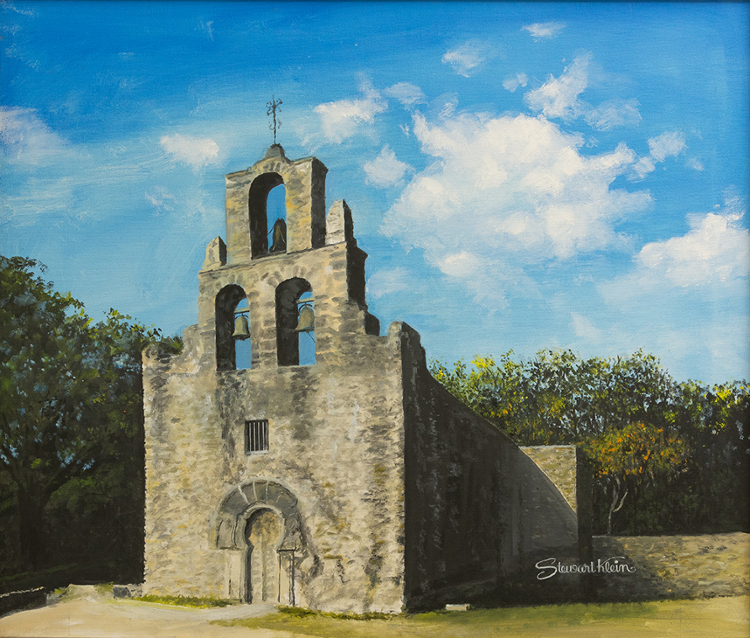
The Works of Stewart Klein
Recognized in art circles of New York and Boston, Stewart Klein was a graduate of the Franklyn School of Design and of the Pratt Institute. He built a successful career as a graphic artist and oil painter then moved to San Antonio late in life. While in San Antonio, he became well known for traditional landscapes and still-lives.
Among his many logos, he designed the logo painting of “Voices de la Luna”, San Antonio’s poetry and arts magazine. His mission-series portraits were commissioned and gifted to the university in honor of Dr. Maria Hernandez Ferrier’s inauguration as the first President of Texas A&M–San Antonio in 2010.
Stewart Klein (American,1924-2012)
Portrait of Mission Espada
Oil on canvas
Signed l.r.
24 x 28 inches
Arcos del Conocimiento
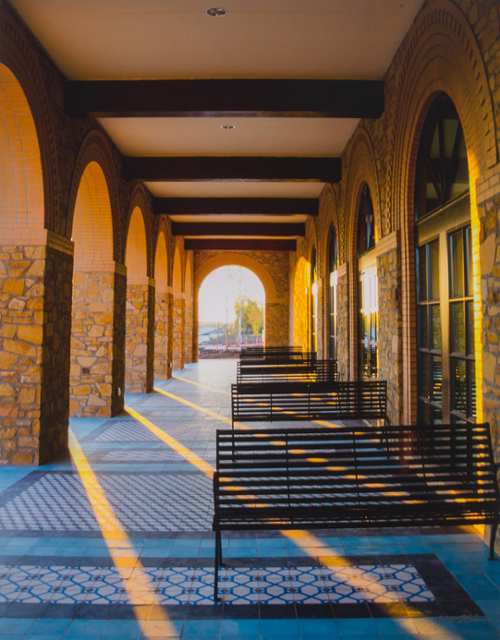
The Works of Cornelio Ontiveros
Veteran Cornelio Ontiveros, was a former A&M-SA student who would wander the campus very early in the morning in order to capture the angles and shadows from the morning sunlight. His thought provoking images are the result of these early morning wanderings and the desire to share his appreciation of our great university.
Texas A&M San Antonio Retrospective
Cornelio Ontiveros (American, b. 1960)
Arcos del Conocimiento (Translation: Arches of Knowledge)
Photography
Signed l.r.
30 x 23 ½ inches
Viaje de Caracter
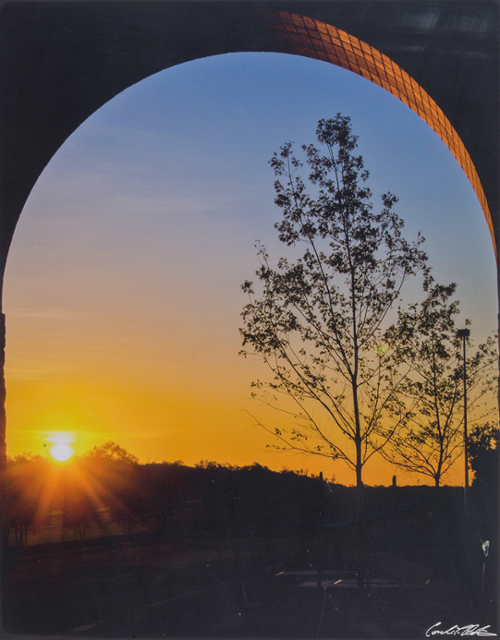
The Works of Cornelio Ontiveros
Veteran Cornelio Ontiveros, was a former A&M-SA student who would wander the campus very early in the morning in order to capture the angles and shadows from the morning sunlight. His thought provoking images are the result of these early morning wanderings and the desire to share his appreciation of our great university.
Texas A&M San Antonio Retrospective
Cornelio Ontiveros (American, b. 1960)
Viaje de Caracter (Translation: Journey of Character)
Photography
Signed l.r.
30 x 23 ½ inches
Torre de Los Suenos (Tower of Dreams)
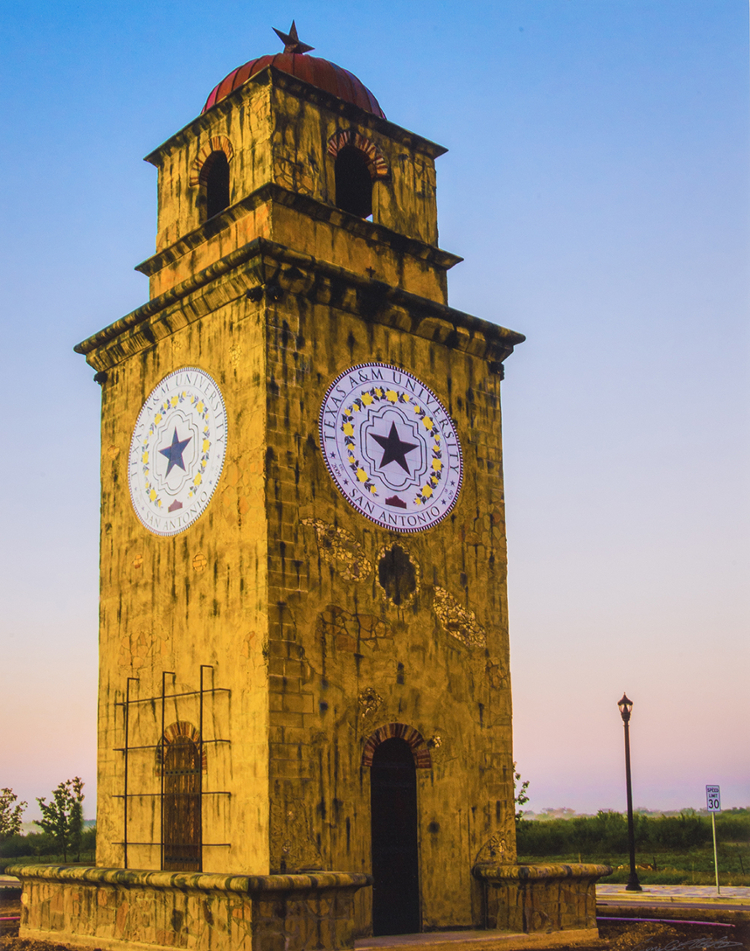
The Works of Cornelio Ontiveros
Veteran Cornelio Ontiveros, was a former A&M-SA student who would wander the campus very early in the morning in order to capture the angles and shadows from the morning sunlight. His thought provoking images are the result of these early morning wanderings and the desire to share his appreciation of our great university.
Texas A&M San Antonio Retrospective
Cornelio Ontiveros (American, b. 1960)
Torre de Los Sueños (Translation: Tower of Dreams)
Photography
Signed l.r.
30 x 23 ½ inches
Campus at Dawn, Retrospective

The Works of Cornelio Ontiveros
Veteran Cornelio Ontiveros, was a former A&M-SA student who would wander the campus very early in the morning in order to capture the angles and shadows from the morning sunlight. His thought provoking images are the result of these early morning wanderings and the desire to share his appreciation of our great university.
Texas A&M San Antonio Retrospective
Cornelio Ontiveros (American, b. 1960)
Campus at Dawn, Retrospective
Photography
Signed l.r.
30 x 23 ½ inches
Senora Lopez
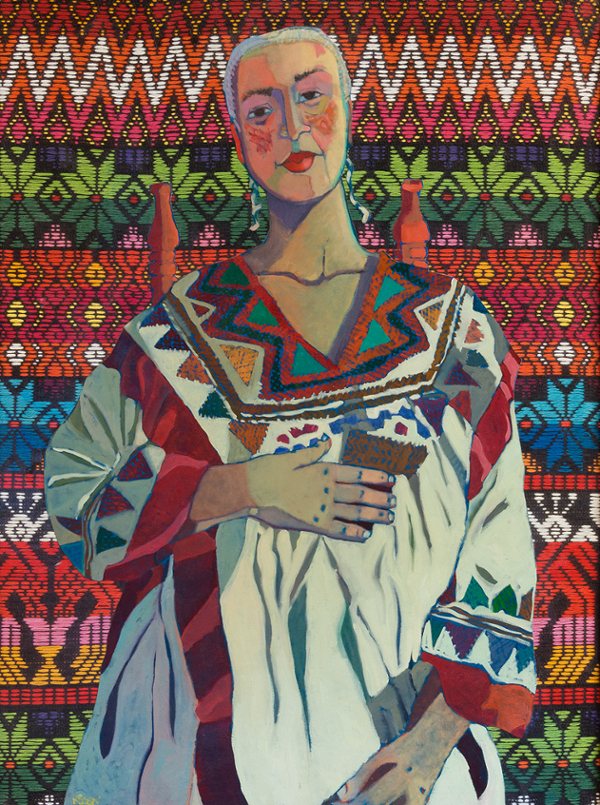
The Works of Kathy Sosa
Kathy Sosa moved to San Antonio from Alabama as a child and immediately fell in love with the blended culture of the Texas-Mexico border region. After earning her bachelor’s and master’s degrees at St. Mary’s University, she spent years in advertising and political consulting. Kathy began her life as a painter during her late 40’s and embraced the artistic expressions of the Mestisaje culture. Her work has been exhibited at the Smithsonian Latino Center in Washington D.C. and regionally in Texas; it has also been featured on CNN and in various publications.
“Everything in my body of work is about the Mestizo culture that I live in, and I would like to bring to people’s attention to the very cool things about the blended culture in the Texas-Mexico border land… It’s a distinct culture of its own” ---Kathy Sosa
From the Huipiles Series
The artist makes the point: “It is important to know these are things (wearing huipiles) that are happening now! Not in the past! The wearers incorporate these cultural garments into their wardrobes…what we do is find beautiful things from our culture, beautiful things that we stumble over and see and …you are wearing it to carry something from the past forward or from the present into another place.” --- Kathy Sosa
Kathy Sosa (American, b. 20th Century)
Señora Lopez
Oil portrait with collage on board
Signed l.l.
45 ½ x 34 inches
The sitter was responsible for mentoring a whole group of women about the Huipiles (the indigenous embroidered dresses and blouses). She instructed the group on how to wear the Mexican costume from the various regions and how to accessorize them correctly while providing reasons why. This group of women shared words of her knowledge throughout San Antonio. The portrait, which hung at the Smithsonian, is a part of the Huipiles Series.
Chili Lillies
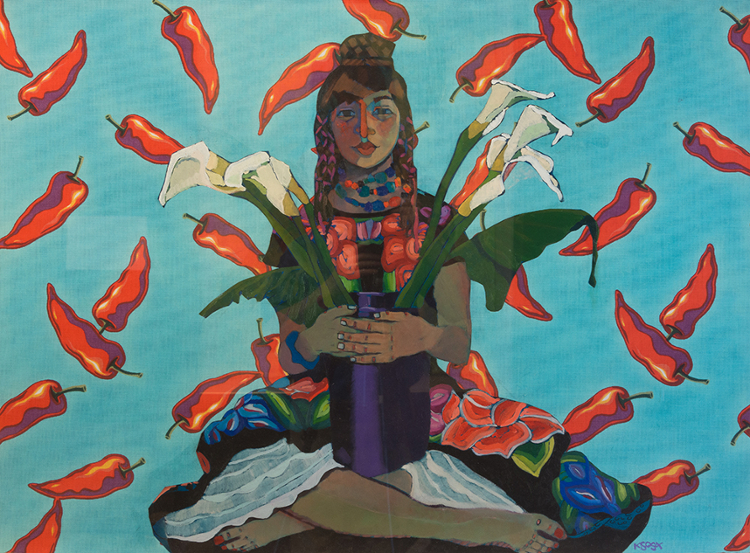
The Works of Kathy Sosa
Kathy Sosa moved to San Antonio from Alabama as a child and immediately fell in love with the blended culture of the Texas-Mexico border region. After earning her bachelor’s and master’s degrees at St. Mary’s University, she spent years in advertising and political consulting. Kathy began her life as a painter during her late 40’s and embraced the artistic expressions of the Mestisaje culture. Her work has been exhibited at the Smithsonian Latino Center in Washington D.C. and regionally in Texas; it has also been featured on CNN and in various publications.
“Everything in my body of work is about the Mestizo culture that I live in, and I would like to bring to people’s attention to the very cool things about the blended culture in the Texas-Mexico border land… It’s a distinct culture of its own” ---Kathy Sosa
From the Huipiles Series
The artist makes the point: “It is important to know these are things (wearing huipiles) that are happening now! Not in the past! The wearers incorporate these cultural garments into their wardrobes…what we do is find beautiful things from our culture, beautiful things that we stumble over and see and …you are wearing it to carry something from the past forward or from the present into another place.” --- Kathy Sosa
Kathy Sosa (American, b. 20th Century)
Chili Lillies
Giclée with oil on watercolor paper
Signed l.r.
31 x 42 inches
Mujer en Morado
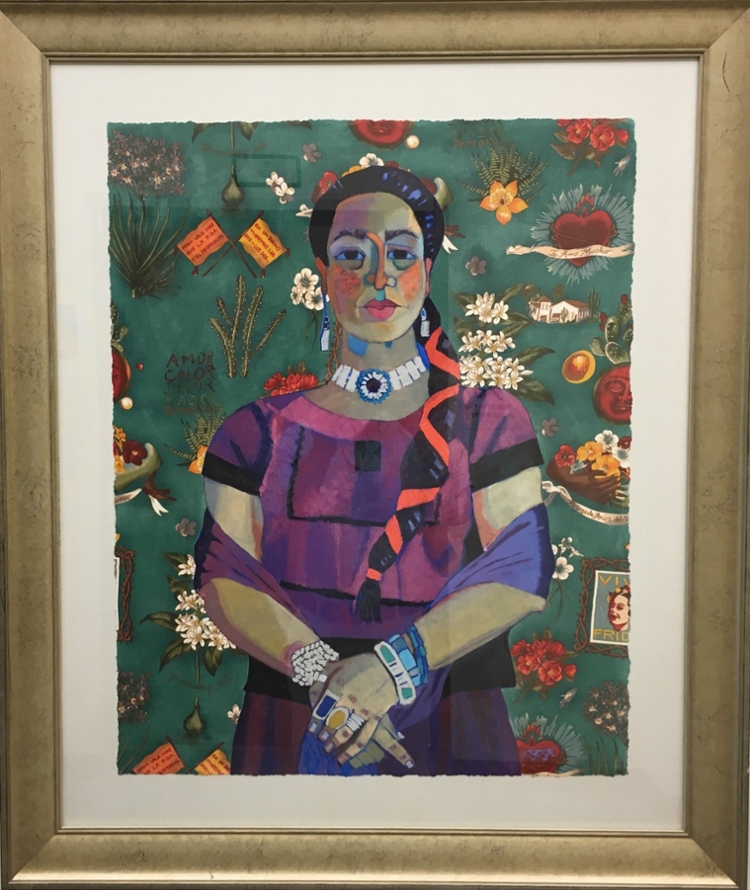
The Works of Kathy Sosa
Kathy Sosa moved to San Antonio from Alabama as a child and immediately fell in love with the blended culture of the Texas-Mexico border region. After earning her bachelor’s and master’s degrees at St. Mary’s University, she spent years in advertising and political consulting. Kathy began her life as a painter during her late 40’s and embraced the artistic expressions of the Mestisaje culture. Her work has been exhibited at the Smithsonian Latino Center in Washington D.C. and regionally in Texas; it has also been featured on CNN and in various publications.
“Everything in my body of work is about the Mestizo culture that I live in, and I would like to bring to people’s attention to the very cool things about the blended culture in the Texas-Mexico border land… It’s a distinct culture of its own” ---Kathy Sosa
From the Huipiles Series
The artist makes the point: “It is important to know these are things (wearing huipiles) that are happening now! Not in the past! The wearers incorporate these cultural garments into their wardrobes…what we do is find beautiful things from our culture, beautiful things that we stumble over and see and …you are wearing it to carry something from the past forward or from the present into another place.” --- Kathy Sosa
Kathy Sosa (American, b. 20th Century)
Mujer en Morado
Giclée with oil on watercolor paper
Signed l.r.
30 ½ x 24 ½ inches
“…there is a magical transformation that happens to every woman who puts on a huipil.” ---the Artist
Olivia's Offering
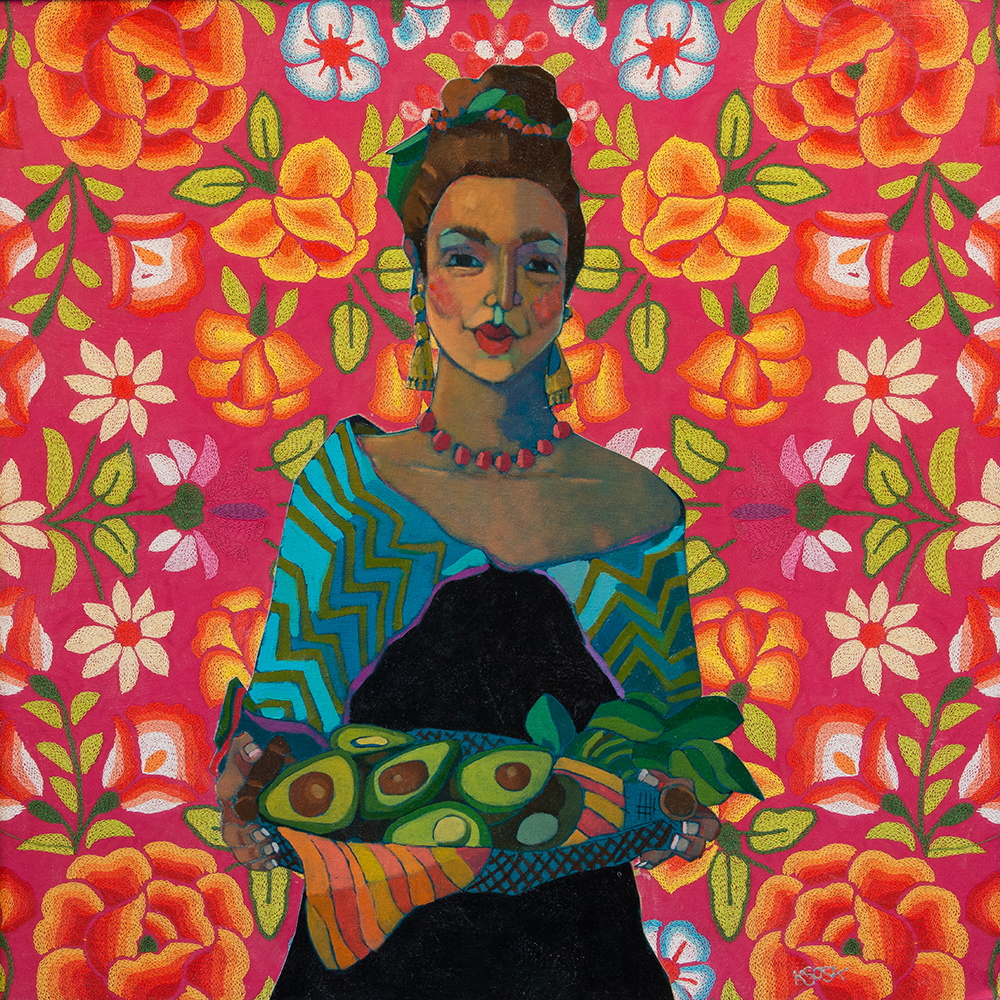
The Works of Kathy Sosa
Kathy Sosa moved to San Antonio from Alabama as a child and immediately fell in love with the blended culture of the Texas-Mexico border region. After earning her bachelor’s and master’s degrees at St. Mary’s University, she spent years in advertising and political consulting. Kathy began her life as a painter during her late 40’s and embraced the artistic expressions of the Mestisaje culture. Her work has been exhibited at the Smithsonian Latino Center in Washington D.C. and regionally in Texas; it has also been featured on CNN and in various publications.
“Everything in my body of work is about the Mestizo culture that I live in, and I would like to bring to people’s attention to the very cool things about the blended culture in the Texas-Mexico border land… It’s a distinct culture of its own” ---Kathy Sosa
From the Huipiles Series
The artist makes the point: “It is important to know these are things (wearing huipiles) that are happening now! Not in the past! The wearers incorporate these cultural garments into their wardrobes…what we do is find beautiful things from our culture, beautiful things that we stumble over and see and …you are wearing it to carry something from the past forward or from the present into another place.” --- Kathy Sosa
Kathy Sosa (American, b. 20th Century)
Olivia’s Offering
Oil portrait with collage on watercolor paper
Signed l.r.
30 ½ x 30 ½ inches
The sitter in the portrait holds a basket of “aquacate,” or avocado, offering it to the viewer. Her huipil has been digitally manipulated from an actual huipil to its present state. The artist admits she herself is a “Huipilista”.
Dr. Maria Hernandez Ferrier
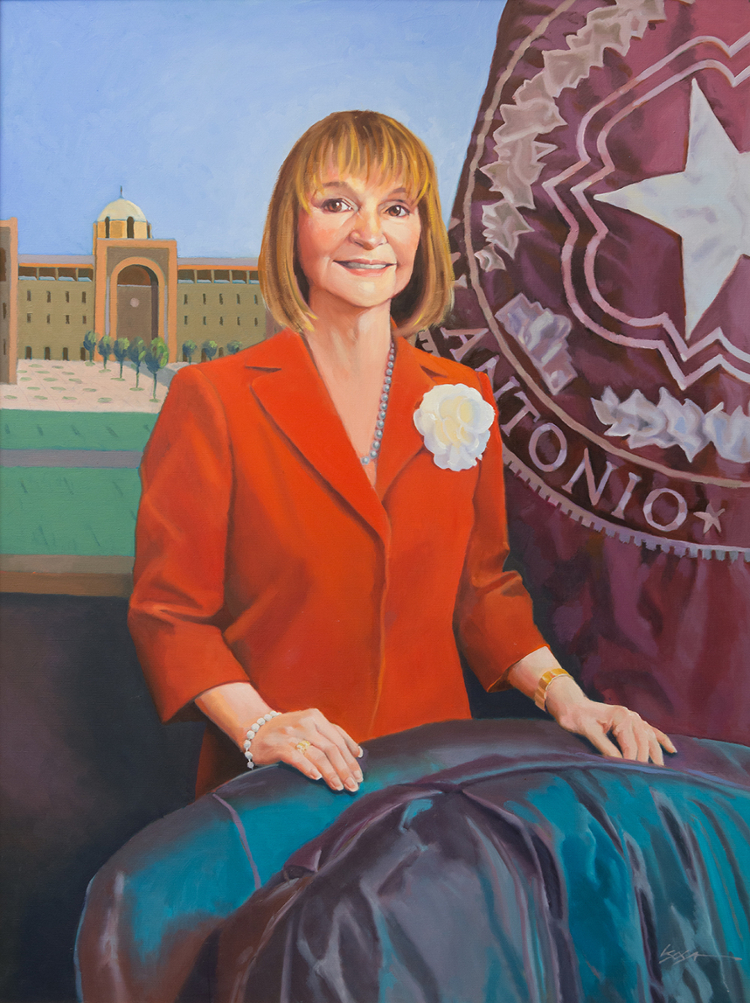
Maria Hernandez Ferrier was invested as the inaugural president of Texas A&M University-San Antonio in 2010 after serving as interim president when Governor Rick Perry signed Senate Bill 629, designating A&M-San Antonio as a stand-alone institution. Dr. Ferrier was the driving force behind the University's unprecedented growth and development and had the vision to create the beautiful Main Campus on One University Way, including the first building, later memorialized as the Senator Frank L. Madla Building, the Central Academic Building, which serves as the iconic center of the growing campus, and the unique Patriots' Casa, academic home of the brave.
Dr. Ferrier oversaw the creation of the first 22 undergraduate programs and 10 graduate programs, giving students the freedom to choose from a wide variety of fields. She lead the University's independent accreditation from the Southern Association of Colleges and Schools Commission on Colleges, a major milestone in the University's development. Dr. Ferrier guided the University to be Military-Embracing committed to providing the best service to the military community and honoring their courage and devotion to the country. She established the Educational & Cultural Arts Center, located in the heart of historic downtown San Antonio, to celebrate the city's cultural heritage and provide opportunities to the San Antonio community to learn more about Latino art. She brought beauty to the spirit of South San Antonio to Main campus with imported Mexican artisan tiles, San Saba sandstone and the President's Rose Garden in the courtyard of the Madla Building.
Lionel Sosa (American, b. 20th Century)
Dr. Maria Hernandez Ferrier
Oil on canvas
Signed l.r.
47 x 36 inches
John Sharp, Texas A&M University System Chancellor said it best, "Even a life-size portrait of Dr. Maria Hernandez Ferrier is not big enough to capture her inner strength, heart and spirit."
In this portrait, I tried to capture Dr. Ferrier's immense inner strength, her dignity, as well as her compassionate heart. Her loyalty to the A&M spirit is expressed by the Texas A&M-San Antonio flag to her left. In the background, we see the main building she carefully nurtured to completion - this building is the hub of the young campus, destined to one day become one of the largest in the A&M System. Her hands rest on the maroon leather chair in her office, signifying her steady and sure leadership. Her stately posture illustrated pride in her country and a lifetime replete with accomplishments. I was honored to be chosen as the artist to paint her official portrait.
El Gallo
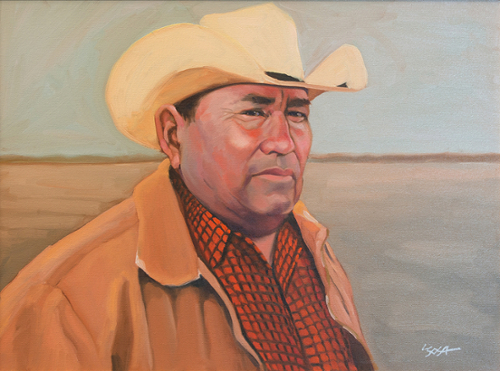
The Works of Lionel Sosa
Lionel Sosa was raised in humble neighborhoods of San Antonio’s west side, it was an upbringing filled with the rich elements of Mexican-American culture. As a young man, he served his country in the United States Marine Corp until his creative talents landed him in the advertising business.
This Tejano Renaissance man is well known for his ability to connect with Hispanic-American markets as both a political consultant and advertising pioneer. In 1995, Sosa retired from his highly successful advertising business to devote more time to his family and to his painting alongside his wife, Kathy Sosa.
In addition to being a naturally talented artist, he is an accomplished writer, authoring three books and coauthoring two more. In 2005, Sosa was recognized as one of the 25 most influential Hispanics in America by Time Magazine. He was also named to the Texas Business Hall of fame. Today, the artist devotes much of his energy serving on various nonprofit boards in San Antonio.
The artist says this of his paintings, “I am not so much trying to paint a likeness as I am the essence of the person.”
“Whatever I do, I do it with a passion.”--- Lionel Sosa
Vaqueros Series
The Mexican Vaquero is the original American Cowboy.
The land on which this university sits was a part of El Camino Real, the Royal Road of New Spain. During the 18th Century, Tejano Vaqueros and Rancheros along with Mission Indians drove cattle up El Camino Real over these fields. The vaqueros drove cattle through Texas to Louisiana and north on the orders of Don Bernardo Galvez, Governor of Spanish Louisiana. George Washington requested aid from Galvez in 1779 during the American revolutionary war. In addition to the cattle, which were needed for food, a voluntary contribution of approximately 10,000 pesos was sent from the Tejano citizens. Many of the vaqueros stayed to fight against the British in Don Bernardo de Galvez’s army during the revolutionary war.
A&M-SA was awarded State Historic Site Designation, which recognizes the historical relevance of this land, and by extension, the vaqueros and their role in American history.
These portraits showcase descendants of the Mexican and Spanish vaqueros. The vaqueros of long ago brought their horsemanship skills and their work ethic, teaching and working, alongside their Anglo counterparts.
Lionel Sosa (American, b. 20th Century)
El Gallo
Oil on canvas
Signed l.r.
18 x 24 inches
Quatro Vaqueros
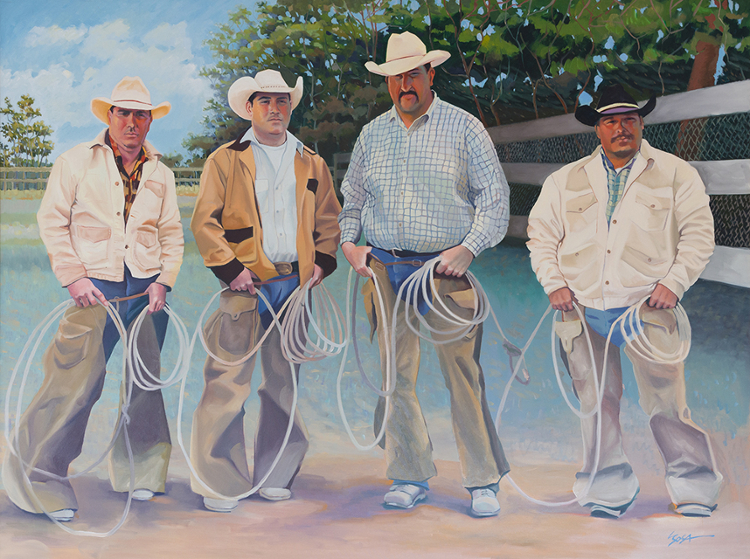
The Works of Lionel Sosa
Lionel Sosa was raised in humble neighborhoods of San Antonio’s west side, it was an upbringing filled with the rich elements of Mexican-American culture. As a young man, he served his country in the United States Marine Corp until his creative talents landed him in the advertising business.
This Tejano Renaissance man is well known for his ability to connect with Hispanic-American markets as both a political consultant and advertising pioneer. In 1995, Sosa retired from his highly successful advertising business to devote more time to his family and to his painting alongside his wife, Kathy Sosa.
In addition to being a naturally talented artist, he is an accomplished writer, authoring three books and coauthoring two more. In 2005, Sosa was recognized as one of the 25 most influential Hispanics in America by Time Magazine. He was also named to the Texas Business Hall of fame. Today, the artist devotes much of his energy serving on various nonprofit boards in San Antonio.
The artist says this of his paintings, “I am not so much trying to paint a likeness as I am the essence of the person.”
“Whatever I do, I do it with a passion.”--- Lionel Sosa
Vaqueros Series
The Mexican Vaquero is the original American Cowboy.
The land on which this university sits was a part of El Camino Real, the Royal Road of New Spain. During the 18th Century, Tejano Vaqueros and Rancheros along with Mission Indians drove cattle up El Camino Real over these fields. The vaqueros drove cattle through Texas to Louisiana and north on the orders of Don Bernardo Galvez, Governor of Spanish Louisiana. George Washington requested aid from Galvez in 1779 during the American revolutionary war. In addition to the cattle, which were needed for food, a voluntary contribution of approximately 10,000 pesos was sent from the Tejano citizens. Many of the vaqueros stayed to fight against the British in Don Bernardo de Galvez’s army during the revolutionary war.
A&M-SA was awarded State Historic Site Designation, which recognizes the historical relevance of this land, and by extension, the vaqueros and their role in American history.
These portraits showcase descendants of the Mexican and Spanish vaqueros. The vaqueros of long ago brought their horsemanship skills and their work ethic, teaching and working, alongside their Anglo counterparts.
Lionel Sosa (American, b. 20th Century)
Quatro Vaqueros
Oil on canvas
Signed l.r.
6 x 8 feet
El Maestro
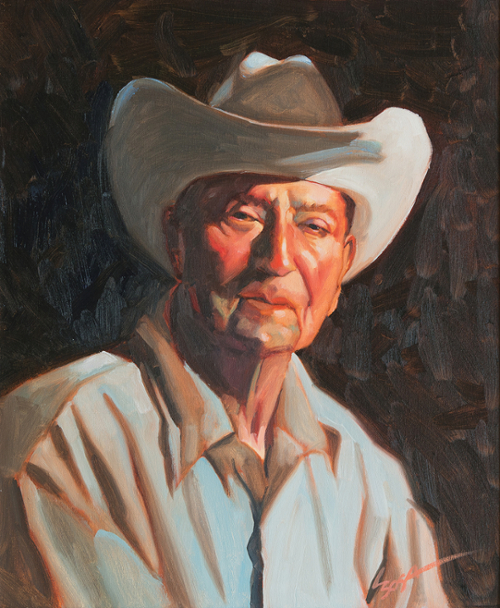
The Works of Lionel Sosa
Lionel Sosa was raised in humble neighborhoods of San Antonio’s west side, it was an upbringing filled with the rich elements of Mexican-American culture. As a young man, he served his country in the United States Marine Corp until his creative talents landed him in the advertising business.
This Tejano Renaissance man is well known for his ability to connect with Hispanic-American markets as both a political consultant and advertising pioneer. In 1995, Sosa retired from his highly successful advertising business to devote more time to his family and to his painting alongside his wife, Kathy Sosa.
In addition to being a naturally talented artist, he is an accomplished writer, authoring three books and coauthoring two more. In 2005, Sosa was recognized as one of the 25 most influential Hispanics in America by Time Magazine. He was also named to the Texas Business Hall of fame. Today, the artist devotes much of his energy serving on various nonprofit boards in San Antonio.
The artist says this of his paintings, “I am not so much trying to paint a likeness as I am the essence of the person.”
“Whatever I do, I do it with a passion.”--- Lionel Sosa
Vaqueros Series
The Mexican Vaquero is the original American Cowboy.
The land on which this university sits was a part of El Camino Real, the Royal Road of New Spain. During the 18th Century, Tejano Vaqueros and Rancheros along with Mission Indians drove cattle up El Camino Real over these fields. The vaqueros drove cattle through Texas to Louisiana and north on the orders of Don Bernardo Galvez, Governor of Spanish Louisiana. George Washington requested aid from Galvez in 1779 during the American revolutionary war. In addition to the cattle, which were needed for food, a voluntary contribution of approximately 10,000 pesos was sent from the Tejano citizens. Many of the vaqueros stayed to fight against the British in Don Bernardo de Galvez’s army during the revolutionary war.
A&M-SA was awarded State Historic Site Designation, which recognizes the historical relevance of this land, and by extension, the vaqueros and their role in American history.
These portraits showcase descendants of the Mexican and Spanish vaqueros. The vaqueros of long ago brought their horsemanship skills and their work ethic, teaching and working, alongside their Anglo counterparts.
Lionel Sosa (American, b. 20th Century)
El Maestro
Oil on canvas
Signed l.r.
24 x 20 inches
The Wise Man
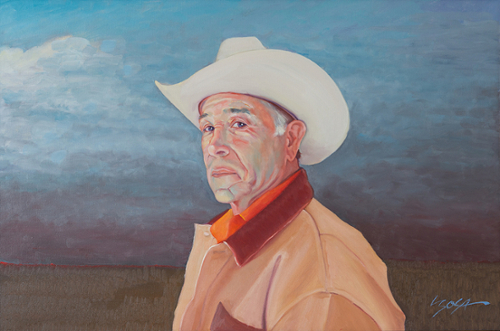
The Works of Lionel Sosa
Lionel Sosa was raised in humble neighborhoods of San Antonio’s west side, it was an upbringing filled with the rich elements of Mexican-American culture. As a young man, he served his country in the United States Marine Corp until his creative talents landed him in the advertising business.
This Tejano Renaissance man is well known for his ability to connect with Hispanic-American markets as both a political consultant and advertising pioneer. In 1995, Sosa retired from his highly successful advertising business to devote more time to his family and to his painting alongside his wife, Kathy Sosa.
In addition to being a naturally talented artist, he is an accomplished writer, authoring three books and coauthoring two more. In 2005, Sosa was recognized as one of the 25 most influential Hispanics in America by Time Magazine. He was also named to the Texas Business Hall of fame. Today, the artist devotes much of his energy serving on various nonprofit boards in San Antonio.
The artist says this of his paintings, “I am not so much trying to paint a likeness as I am the essence of the person.”
“Whatever I do, I do it with a passion.”--- Lionel Sosa
Vaqueros Series
The Mexican Vaquero is the original American Cowboy.
The land on which this university sits was a part of El Camino Real, the Royal Road of New Spain. During the 18th Century, Tejano Vaqueros and Rancheros along with Mission Indians drove cattle up El Camino Real over these fields. The vaqueros drove cattle through Texas to Louisiana and north on the orders of Don Bernardo Galvez, Governor of Spanish Louisiana. George Washington requested aid from Galvez in 1779 during the American revolutionary war. In addition to the cattle, which were needed for food, a voluntary contribution of approximately 10,000 pesos was sent from the Tejano citizens. Many of the vaqueros stayed to fight against the British in Don Bernardo de Galvez’s army during the revolutionary war.
A&M-SA was awarded State Historic Site Designation, which recognizes the historical relevance of this land, and by extension, the vaqueros and their role in American history.
These portraits showcase descendants of the Mexican and Spanish vaqueros. The vaqueros of long ago brought their horsemanship skills and their work ethic, teaching and working, alongside their Anglo counterparts.
Lionel Sosa (American, b. 20th Century)
The Wise Man
Oil on canvas
Signed l.r
24 x 36 inches
El Guapo
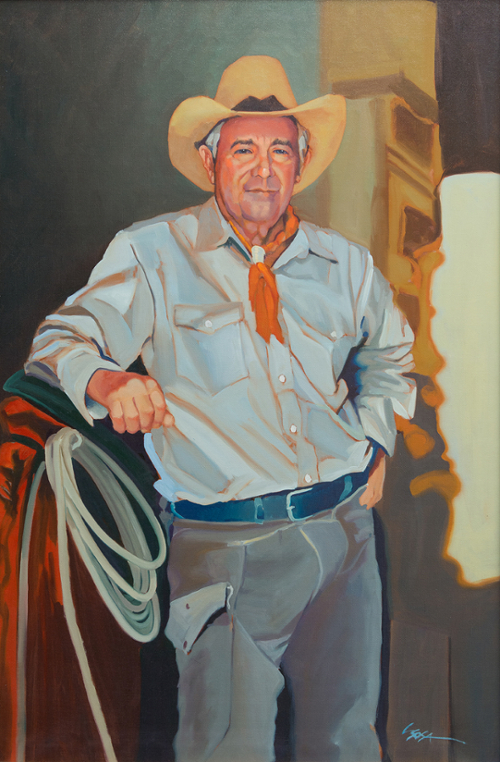
The Works of Lionel Sosa
Lionel Sosa was raised in humble neighborhoods of San Antonio’s west side, it was an upbringing filled with the rich elements of Mexican-American culture. As a young man, he served his country in the United States Marine Corp until his creative talents landed him in the advertising business.
This Tejano Renaissance man is well known for his ability to connect with Hispanic-American markets as both a political consultant and advertising pioneer. In 1995, Sosa retired from his highly successful advertising business to devote more time to his family and to his painting alongside his wife, Kathy Sosa.
In addition to being a naturally talented artist, he is an accomplished writer, authoring three books and coauthoring two more. In 2005, Sosa was recognized as one of the 25 most influential Hispanics in America by Time Magazine. He was also named to the Texas Business Hall of fame. Today, the artist devotes much of his energy serving on various nonprofit boards in San Antonio.
The artist says this of his paintings, “I am not so much trying to paint a likeness as I am the essence of the person.”
“Whatever I do, I do it with a passion.”--- Lionel Sosa
Vaqueros Series
The Mexican Vaquero is the original American Cowboy.
The land on which this university sits was a part of El Camino Real, the Royal Road of New Spain. During the 18th Century, Tejano Vaqueros and Rancheros along with Mission Indians drove cattle up El Camino Real over these fields. The vaqueros drove cattle through Texas to Louisiana and north on the orders of Don Bernardo Galvez, Governor of Spanish Louisiana. George Washington requested aid from Galvez in 1779 during the American revolutionary war. In addition to the cattle, which were needed for food, a voluntary contribution of approximately 10,000 pesos was sent from the Tejano citizens. Many of the vaqueros stayed to fight against the British in Don Bernardo de Galvez’s army during the revolutionary war.
A&M-SA was awarded State Historic Site Designation, which recognizes the historical relevance of this land, and by extension, the vaqueros and their role in American history.
These portraits showcase descendants of the Mexican and Spanish vaqueros. The vaqueros of long ago brought their horsemanship skills and their work ethic, teaching and working, alongside their Anglo counterparts.
Lionel Sosa (American, b. 20th Century)
El Guapo
Oil on canvas
Signed l.r.
36 x 24 inches
Como Hermanos
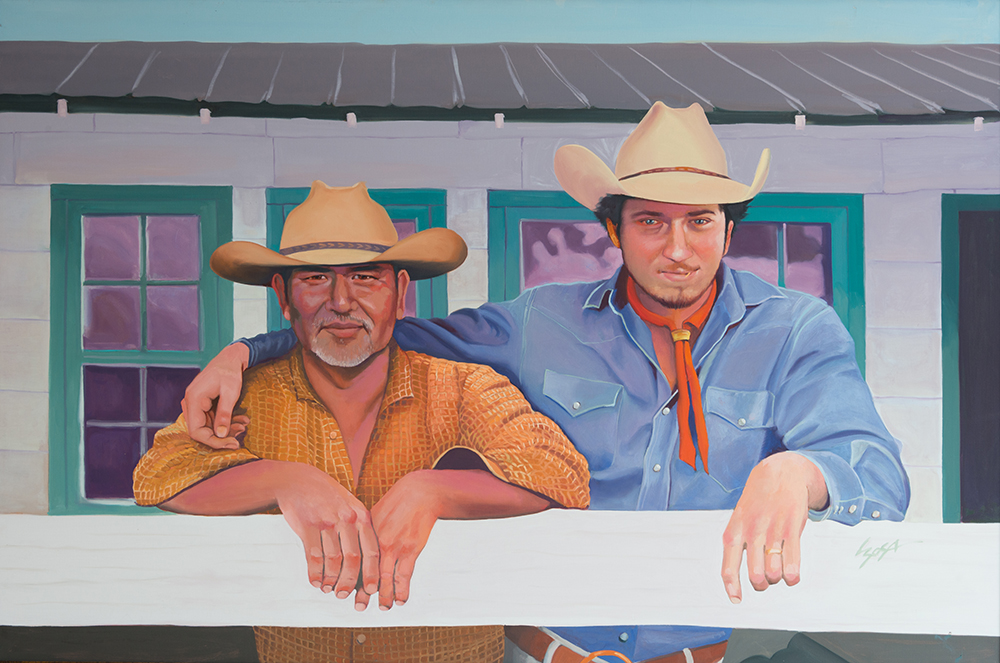
The Works of Lionel Sosa
Lionel Sosa was raised in humble neighborhoods of San Antonio’s west side, it was an upbringing filled with the rich elements of Mexican-American culture. As a young man, he served his country in the United States Marine Corp until his creative talents landed him in the advertising business.
This Tejano Renaissance man is well known for his ability to connect with Hispanic-American markets as both a political consultant and advertising pioneer. In 1995, Sosa retired from his highly successful advertising business to devote more time to his family and to his painting alongside his wife, Kathy Sosa.
In addition to being a naturally talented artist, he is an accomplished writer, authoring three books and coauthoring two more. In 2005, Sosa was recognized as one of the 25 most influential Hispanics in America by Time Magazine. He was also named to the Texas Business Hall of fame. Today, the artist devotes much of his energy serving on various nonprofit boards in San Antonio.
The artist says this of his paintings, “I am not so much trying to paint a likeness as I am the essence of the person.”
“Whatever I do, I do it with a passion.”--- Lionel Sosa
Vaqueros Series
The Mexican Vaquero is the original American Cowboy.
The land on which this university sits was a part of El Camino Real, the Royal Road of New Spain. During the 18th Century, Tejano Vaqueros and Rancheros along with Mission Indians drove cattle up El Camino Real over these fields. The vaqueros drove cattle through Texas to Louisiana and north on the orders of Don Bernardo Galvez, Governor of Spanish Louisiana. George Washington requested aid from Galvez in 1779 during the American revolutionary war. In addition to the cattle, which were needed for food, a voluntary contribution of approximately 10,000 pesos was sent from the Tejano citizens. Many of the vaqueros stayed to fight against the British in Don Bernardo de Galvez’s army during the revolutionary war.
A&M-SA was awarded State Historic Site Designation, which recognizes the historical relevance of this land, and by extension, the vaqueros and their role in American history.
These portraits showcase descendants of the Mexican and Spanish vaqueros. The vaqueros of long ago brought their horsemanship skills and their work ethic, teaching and working, alongside their Anglo counterparts.
Lionel Sosa (American, b. 20th Century)
Como Hermanos
Oil on canvas
Signed l.r.
40 x 60 inches
Blackie
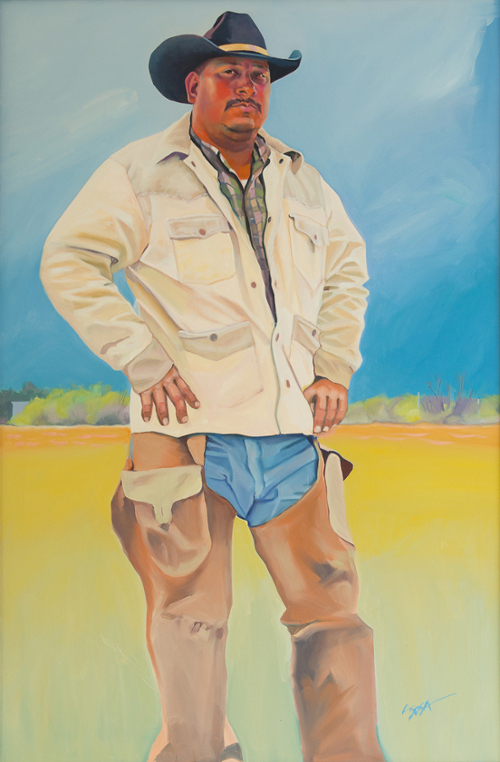
The Works of Lionel Sosa
Lionel Sosa was raised in humble neighborhoods of San Antonio’s west side, it was an upbringing filled with the rich elements of Mexican-American culture. As a young man, he served his country in the United States Marine Corp until his creative talents landed him in the advertising business.
This Tejano Renaissance man is well known for his ability to connect with Hispanic-American markets as both a political consultant and advertising pioneer. In 1995, Sosa retired from his highly successful advertising business to devote more time to his family and to his painting alongside his wife, Kathy Sosa.
In addition to being a naturally talented artist, he is an accomplished writer, authoring three books and coauthoring two more. In 2005, Sosa was recognized as one of the 25 most influential Hispanics in America by Time Magazine. He was also named to the Texas Business Hall of fame. Today, the artist devotes much of his energy serving on various nonprofit boards in San Antonio.
The artist says this of his paintings, “I am not so much trying to paint a likeness as I am the essence of the person.”
“Whatever I do, I do it with a passion.”--- Lionel Sosa
Vaqueros Series
The Mexican Vaquero is the original American Cowboy.
The land on which this university sits was a part of El Camino Real, the Royal Road of New Spain. During the 18th Century, Tejano Vaqueros and Rancheros along with Mission Indians drove cattle up El Camino Real over these fields. The vaqueros drove cattle through Texas to Louisiana and north on the orders of Don Bernardo Galvez, Governor of Spanish Louisiana. George Washington requested aid from Galvez in 1779 during the American revolutionary war. In addition to the cattle, which were needed for food, a voluntary contribution of approximately 10,000 pesos was sent from the Tejano citizens. Many of the vaqueros stayed to fight against the British in Don Bernardo de Galvez’s army during the revolutionary war.
A&M-SA was awarded State Historic Site Designation, which recognizes the historical relevance of this land, and by extension, the vaqueros and their role in American history.
These portraits showcase descendants of the Mexican and Spanish vaqueros. The vaqueros of long ago brought their horsemanship skills and their work ethic, teaching and working, alongside their Anglo counterparts.
Lionel Sosa (American, b. 20th Century)
Blackie
Oil on canvas
Signed l.r.
60 x 40 inches
Amigas
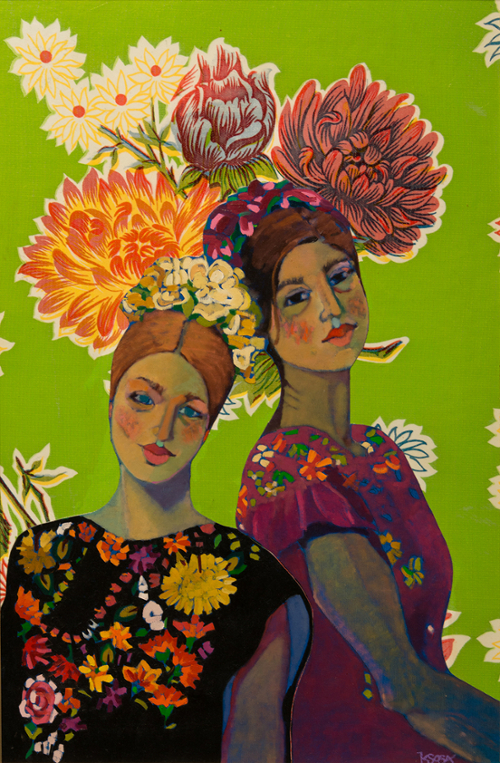
The Works of Kathy Sosa
Kathy Sosa moved to San Antonio from Alabama as a child and immediately fell in love with the blended culture of the Texas-Mexico border region. After earning her bachelor’s and master’s degrees at St. Mary’s University, she spent years in advertising and political consulting. Kathy began her life as a painter during her late 40’s and embraced the artistic expressions of the Mestisaje culture. Her work has been exhibited at the Smithsonian Latino Center in Washington D.C. and regionally in Texas; it has also been featured on CNN and in various publications.
“Everything in my body of work is about the Mestizo culture that I live in, and I would like to bring to people’s attention to the very cool things about the blended culture in the Texas-Mexico border land… It’s a distinct culture of its own” ---Kathy Sosa
From the Huipiles Series
The artist makes the point: “It is important to know these are things (wearing huipiles) that are happening now! Not in the past! The wearers incorporate these cultural garments into their wardrobes…what we do is find beautiful things from our culture, beautiful things that we stumble over and see and …you are wearing it to carry something from the past forward or from the present into another place.” --- Kathy Sosa
Kathy Sosa (American, b. 20th Century)
Amigas
Oil portrait with collage on board
Signed l.r.
44 x 32 inches
The portrait shows Kathy Sosa’s stepdaughter and her best friend dressed up in huipiles and headdresses from the artist’s collection. The background, which began as oilcloth, has been digitally manipulated to reduce the scale size of pattern, making it proportional for the subjects.
Reflections
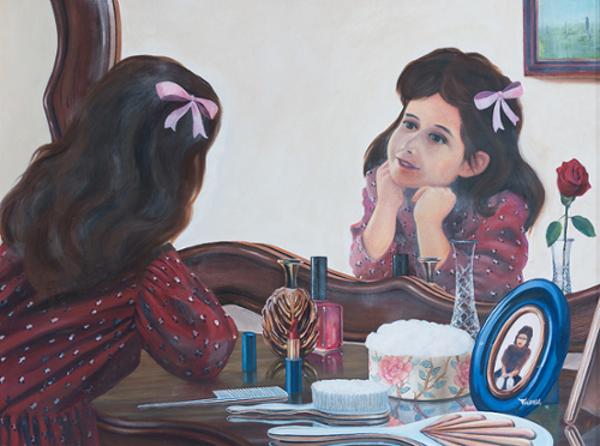
The Works of Joe R. Villarreal
Joe R. Villarreal (American, b. 1953)
Reflections
Oil on canvas
Signed and dated ’95, l.r.
30 x 40 inches
Growing up with three sisters, the artist recalls them taking turns at the mirror. Each girl gazed dreamily at her own reflection contemplating her future. The subject depicts Villarreal’s youngest sister, finally having her turn to view her own youthful face. She sees herself beautiful and blooming. Looking carefully, the viewer sees the reflection of a red rose in the mirror… a rose that is not a reality. In reality, the vase on the dressing table is empty…the little girl has not bloomed…but in her dreams she will.
Nopalitos
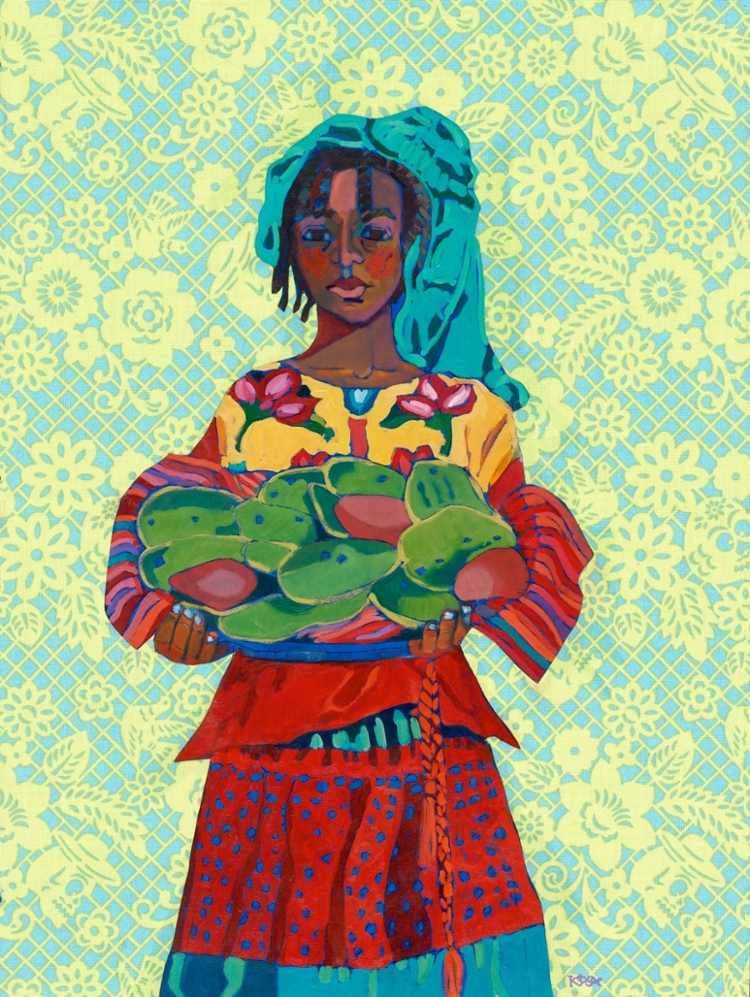
The Works of Kathy Sosa
Kathy Sosa moved to San Antonio from Alabama as a child and immediately fell in love with the blended culture of the Texas-Mexico border region. After earning her bachelor’s and master’s degrees at St. Mary’s University, she spent years in advertising and political consulting. Kathy began her life as a painter during her late 40’s and embraced the artistic expressions of the Mestisaje culture. Her work has been exhibited at the Smithsonian Latino Center in Washington D.C. and regionally in Texas; it has also been featured on CNN and in various publications.
“Everything in my body of work is about the Mestizo culture that I live in, and I would like to bring to people’s attention to the very cool things about the blended culture in the Texas-Mexico border land… It’s a distinct culture of its own” --- Kathy Sosa
From the Huipiles Series
The artist makes the point: “It is important to know these are things (wearing huipiles) that are happening now! Not in the past! The wearers incorporate these cultural garments into their wardrobes…what we do is find beautiful things from our culture, beautiful things that we stumble over and see and …you are wearing it to carry something from the past forward or from the present into another place.” --- Kathy Sosa
Kathy Sosa (American, b. 20 th Century)
Nopalitos
Glicée
Signed l.r
48 ½ x 36 ½ inches
The young woman, a mulatto Latina, holds a platter of nopales (cactus). Her skirt is a ‘China Poblana’, which she combines with a very unusual, colorful huipil. She wears a rebozo in her hair, which is also unusual, as typically the rebozo (shawl) is worn around the shoulders.
The background for this piece comes from a digital manipulation of a novelty fabric resembling ‘papel picado’.
